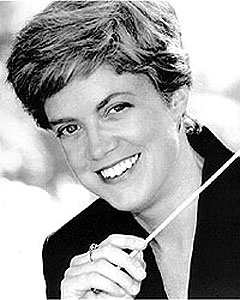|
Audio
Photos
More from MPR
Resources
Respond to this story
|
Help wanted: Maestro
December 24, 2002
Two major regional orchestras in the Upper Midwest are searching for a new Music Director. The Fargo/Moorhead Symphony is interviewing five possible conductors. In Sioux Falls the South Dakota Symphony will form a committee in January to begin a search. Music Director Susan Haig abruptly left during her second season in Sioux Falls.
Sioux Falls, SD — Officials at the South Dakota Symphony Orchestra are tight lipped about why music director Susan Haig resigned. They call it artistic differences. In a recent letter to the Sioux Falls Argus Leader, Haig says she was asked to resign.
Haig came to Sioux Falls as a guest conductor in February of 2000. The search committee had just begun it's work. They planned on auditioning six people during the 2001-2002 season. But after Haig's appearance the committee suddenly switched course and voted unanimously to hire Haig. Executive Director Tom Bennett says there's so much competition for music directors you shouldn't wait.
 | |||
"I don't think the music director search committee made a mistake," says Bennett. "Some of that was - The American Symphony Orchestra League, this group that services all orchestras around the country. They specifically say if you think you have the right match go for it. Even if you're in the middle," says Bennett.
The South Dakota Symphony Orchestra received 200 applications for that search three years ago. In the month since Haig left, it has already received 50.
The Fargo-Moorhead Symphony Orchestra is in what's called a search year season, as the organization auditions potential conductors. The orchestra's leaders have had two seasons to look. Now they've narrowed their pool of candidates to five. Each one will come for a week and lead a concert. Executive Director Bill Law says the audience is involved in the search. Through surveys they'll measure each candidate. Law says they will not make a decision until all of the candidates have spent a week in Fargo-Moorhead with the musicians.
"We are going to look at everybody and not jump for a particular candidate. We think that we have five terrific candidates any one of whom would make us happy and we've seen three thus far and that's proven true, they're very different from each other," says Law.
The Fargo-Moorhead Symphony has had only three music directors in its 71 year history. Law says there should be an announcement on the fourth director by mid-April. He says the search committee is not requiring the conductor to live in the Fargo area. It's now common for conductors to work with two or more orchestras simultaneously. Law says there's an advantage to having a roving maestro.
"You have somebody who's working on their craft so they're growing at a very fast rate and they're out networking," he says. "They work with people who are also doing the same sorts of things. The access you have to fabulous soloists and other people. It's pretty extraordinary as a result," says Law.
There are 18-hundred orchestras in the country. Every year About 150 are looking for a music director. Jack McAuliffe is the vice-president of the American Symphony Orchestra League. He says the success of regional orchestras is due to people wanting art and culture in their community.
"That people see it as an intensely personal experience, that's essential to be shared with others. Which sounds like a dichotomy. Is it personal or communal? Individuals in audiences describe themselves as not listeners but participants. The concert is somehow different because they're there listening to it," says McAuliffe.
In South Dakota, 25% of the season ticket holders live outside Sioux Falls. In Fargo-Moorhead that figure is 10%. McAuliffe says when the economy takes a downturn, and corporations aren't able to donate, individuals step to the plate to ensure their orchestra remains. He says in the last ten years he's known of 15 orchestras that have disbanded because of finances. All but two are back.
|
News Headlines
|
Related Subjects
|

